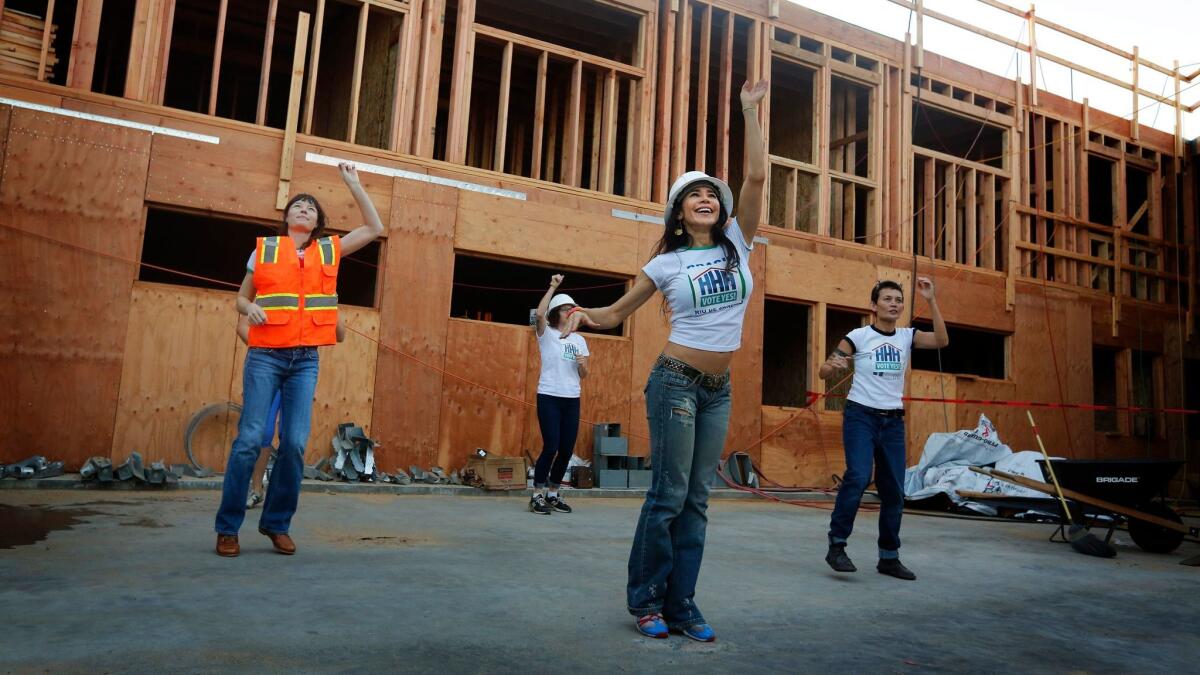Can heartfelt letters from the homeless convince L.A. to pass landmark bond?

- Share via
Someone named Sylvia in Gardena will receive a postcard this week from a resident of skid row.
“Dear Sylvia, I’ve lived on skid row for 17 years,” it says in block letters. “Please join me in voting yes on prop HHH. Measure at end of ballot. Thanks, Dave”
The message is one of 100,000 that have been handwritten in places as far apart as the Central City Outreach Center in skid row and Temple Ahavat Shalom in Northridge.
The cards are one piece of a handcrafted strategy that backers of the Los Angeles city homeless bond proposal on Tuesday’s ballot are using to get over the difficult two-thirds bar for passing a tax measure.
With polling showing homelessness at the top of voter concern, proponents are focusing their effort on two fronts: Motivating voters who are prone to vote yes, and guiding them through the thicket of a ballot with 25 items before Proposition HHH.
“It’s a survivor ballot and we’re at the end of it,” said Mike Shimpock, a principal at SG&A Campaigns, which is running the campaign.
With about $1.2 million to spend, Shimpock is putting almost everything into mailing. Glossy flyers are going out to about 300,000 households with messages such as, “You can help fight homelessness with just your vote.”
Shimpock declined to go into detail about what households are being targeted, but said the goal is to reach demographics likely to favor the measure.
“In a confused, noisy electoral ballot … making them aware that it’s even on the ballot is our primary goal,” Shimpock said.
In a confused, noisy electoral ballot … making them aware that it’s even on the ballot is our primary goal.
— Mike Shimpock, a principal at SG&A; Campaigns
Several veteran political consultants interviewed by The Times said a tax bond campaign would generally target two groups.
Motivational messages would go to those likely to be in favor. Voters likely to be undecided would receive a message designed to persuade. That would be especially important in areas such as the San Fernando Valley, where homelessness may be less visible and opposition to taxes more prevalent.
“You can’t be performing at a 60% margin in the San Fernando Valley” and expect to make up for it south of the mountains, said Sean Clegg, partner in the political consulting firm SCN Strategies. “You have to reach sectors of the electorate that are far more moderate, older, more Republican.”
The high favorable polling of the homelessness bond favors a different approach, Shimpock said.
“In a normal electoral environment any two-thirds format is challenging, but given our outreach it is achievable,” he said.
The campaign is being funded largely by the California Community Foundation, which has contributed $450,000. Los Angeles County Supervisor Mark Ridley-Thomas added $100,000, equaling the $100,000 contributed by the home-sharing website Airbnb. Trade unions and business leaders, including philanthropist Eli Broad, made up the remainder of about a $1.7-million campaign.
Opponents, who say the city should fund homelessness programs from existing revenue, are making appearances at community events but have not organized a committee or raised funds.
A large chunk of that money has been directed to a get-out-the-vote campaign under the umbrella of the United Way of Greater Los Angeles, the measure’s co-coordinator.
Dozens of nonprofit agencies that provide housing and services for the homeless have given the campaign the kind of person-to-person presence that conventional campaigns pay dearly to achieve, through their social media platforms and volunteer bases.
Charitable nonprofits such as United Way are prohibited from engaging in partisan politics, but Internal Revenue Service rules allow them to spend a small percentage of their revenue on advocacy-oriented campaigning to advance their missions.
Elise Buik, president and chief executive of United Way, said the agency first stepped into election advocacy in support of Proposition H in 2006, a homeless housing bond proposal that narrowly failed, receiving 63.9% of the vote.
“We realized if we were going to have an impact we had to weigh in,” Buik said. “You’re starting to see more nonprofits move into this space, influencing good policy, good solutions and the money to support it.”
This year, Buik said, United Way will probably come close to its issue-campaigning limit of about $1 million with its support of Proposition HHH and the quarter-cent sales tax the County Board of Supervisors is expected to put on the March ballot.
The campaign has produced several YouTube videos featuring political leaders and homeless people. One, a collage of actors including Chris Parnell, Michael Rappaport and Jason Ritter, has had 485,000 views on Facebook and Instagram through targeted ad placement, said producer Tommy Newman.
Last week dancers held flash mob events at Grand Park downtown and an unfinished apartment building that will house aging-out foster youth.
Newman, director of communications and public affairs for the homeless services agency L.A. Family Housing, crafted the postcard campaign to draw upon the organizational structure and volunteer bases of similar organizations.
The cards, which will all be mailed to women, considered the most likely yes voters, were pre-addressed then distributed to 42 agencies.
At the Rampart-area headquarters of homeless services agency PATH, employees were served a pizza lunch Friday while they whittled away at 10,000 cards.
Foyin Ani, a compliance manager, and Robert Crocker, a case manager, were locked in a competition to fill out the most cards. Ani, who said she wrote hundreds at home while listening to music, was in the lead with 775.
In a campaign that will likely be decided by a small margin, win or lose, a postcard can make a difference, said Darry Sragow, a veteran campaign consultant who is not working on the Proposition HHH campaign but ran six successful school bond measures in Los Angeles.
“A handwritten message could make a difference ... in a world where we are being bombarded with direct mail,” Sragow said.
Twitter: @LATDoug
ALSO
Attacked, abused and often forgotten: Women now make up 1 in 3 homeless people in L.A. County
Figuring out California’s 17 ballot propositions: Here are the L.A. Times’ endorsements
Essential Politics: Red state, blue state, my state, your state
More to Read
Sign up for Essential California
The most important California stories and recommendations in your inbox every morning.
You may occasionally receive promotional content from the Los Angeles Times.











